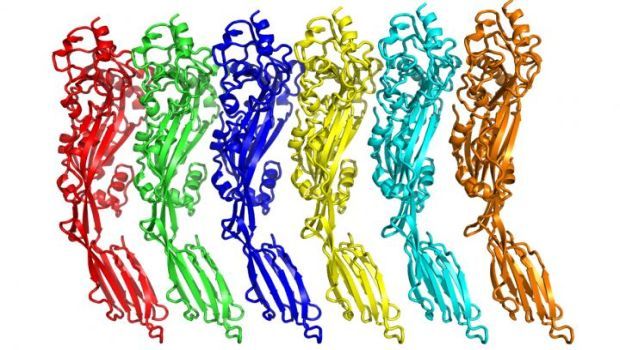Scientists Create Detailed Image of Deadly Bacterial Toxin for the First Time
Scientists from the University of Leicester have for the first time created a detailed image of a toxin - called pneumolysin - associated with deadly infections such as bacterial pneumonia, meningitis and septicemia.


This illustration shows the way that copies of the toxin pack together to form pores in cells. Courtesy of University of Leicester
Scientists from the University of Leicester have for the first time created a detailed image of a toxin called pneumolysin associated with deadly infections such as bacterial pneumonia, meningitis and septicemia.
The three-year study involving four research groups from across the University has been described as an exciting advance because it points to the possibility of creating therapeutics that block assembly of pneumolysin pores to treat people with pneumococcal disease. The university has recently set up a company called Axendos Therapeutics to pursue this aim.
Using a technique called X-ray crystallography at Diamond Light Source, the UK's national synchrotron science facility, the Leicester team was able to see the individual atoms of the toxin. The structure not only reveals what the toxin looks like, but also shows how it assembles on the surface of cells to form lethal pores.
Funded by the Wellcome Trust and the Medical Research Council, the University of Leicester research published in Scientific Reports was led by professor Russell Wallis of the Departments of Infection, Immunity and Inflammation and Molecular and Cell Biology and professor Peter Andrew, head of the Department of Infection, Immunity and Inflammation.
Wallis says, "Our research is about a toxin called pneumolysin produced by a bacterium called pneumococcus (aka Streptococcus pneumoniae). Pneumococcal infections are the leading cause of bacterial pneumonia as well as the cause of a range of other life-threatening diseases such as meningitis and septicemia. Pneumolysin is instrumental in the ability of pneumococcus to cause disease. The World Health Organization (WHO) estimated that more than 1.6 million people die every year from pneumococcal infections, including more than 800,000 children under 5 years old. The aim of the research was to find out how pneumolysin kills our cells, thereby causing tissue damage and contributing to disease. In particular we wanted to find out how multiple copies of the toxin assemble on the surface of cells. We managed to determine the structure of pneumolysin using a technique called X-ray crystallography, which enables us to see the individual atoms of the toxin. The structure not only reveals what the toxin looks like, but also shows how it assembles to form lethal pores. Ours is the first detailed structure of pneumolysin. This level of detail is important and useful because it enables us to begin to understand how the toxin works. For example, we can see which parts of the toxin come together during pore assembly. When we disrupt these contacts, the toxin becomes inactivated so can no longer kill cells. The mode of action of pneumolysin action revealed by our work appears to be conserved in related toxins from other disease-causing bacteria e.g. toxins produced by pathogenic species of Listeria."
Andrew notes, "The determination of the structure of pneumolysin is a thrilling achievement that, worldwide, scientists have been pursuing for more than twenty years. It also offers the real prospect of enhancing our ability to find new drugs for treatment of pneumococcal diseases. Because of fears of antibiotic resistance, researchers have been trying for decades to find new antimicrobial drugs but with little success. A new approach is to identify new targets for therapy and our work over a long period shows that pneumolysin is an excellent target for new treatments. The University of Leicester set up a spin-out company to find drugs that target the toxin. Now the determination of the toxin's structure is an important advance towards achieving this objective."
Wallis says, "The work is especially exciting because of the importance of pneumolysin towards pneumococcal disease and the devastating consequences of pneumococcal infections. Our work has provided new insight into how the toxin kills cells. Much of the experimental work was carried out by two PhD students: Jamie Marshall, who has just completed his PhD and Bayan Faraj, who is in the final year of her project. Overall it has been a real collaborative effort between four research groups across the College of Medicine, Biological Sciences and Psychology involving the groups in the Department of Infection, Immunity and Inflammation as well as the groups of Prof Peter Moody and Dr El-Mezgueldi in the Department of Molecular and Cell Biology."
Source: University of Leicester
Gag Order Puts Public Health at Risk, APIC Urges Immediate Action
February 4th 2025APIC warns that the HHS gag order on CDC communications endangers public health, delaying critical infection updates and weakening outbreak response amid rising tuberculosis, avian flu, Ebola, and measles threats.
Breaking Barriers: The Future of HIV Prevention and the Fight for Widespread PrEP Access
January 31st 2025Despite medical advances, HIV prevention faces roadblocks—low PrEP adoption, stigma, and accessibility issues threaten progress. Experts push for innovative, long-acting solutions to end the epidemic.
The Hidden Dangers of Hospital Ventilation: Are We Spreading Viruses Further?
January 31st 2025New research reveals hospital ventilation and air purifiers may unintentionally spread viral particles, increasing infection risks. Infection preventionists must rethink airflow strategies to protect patients and staff.